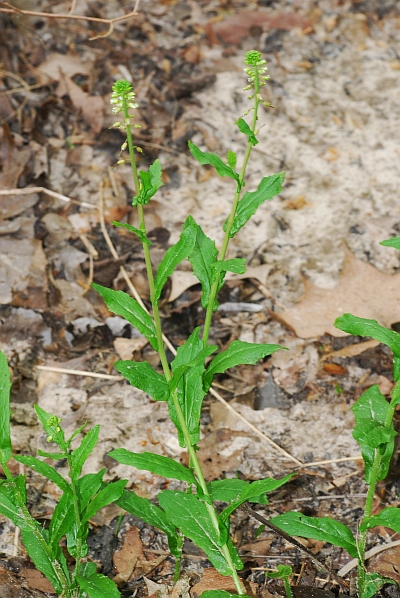Boechera dentata (Raf.) Al-Shehbaz & Zarucchi
Rock Cress

Native
CC = 6
CW = 3
MOC = 49
© SRTurner
Boechera dentata (Raf.) Al-Shehbaz & ZarucchiRock Cress | |
 |
Native CC = 6 CW = 3 MOC = 49 |
© SRTurner |
|
Family - Brassicaceae Habit - Biennial forb from a thin taproot or fibrous roots. Stems - Spreading to weakly ascending, to 50 cm, multiple from base, occasionally branching in upper half, pubescent with 2-4 branched hairs.
Leaves - Alternate, simple, often ascending on stem. Leaves pubescent with simple hairs on the upper surface and with mostly 3- or 4-branched hairs on the undersurface. Basal leaves to 15 cm long, obovate to oblanceolate in outline, irregularly toothed, narrowed at the base to a short or long petiole. Stem leaves 1-6 cm long, narrowly oblanceolate to nearly linear in outline, sessile, clasping the stem, with pointed auricles, sharply and irregularly toothed, nearly glabrous on upper surface, with with minutely hairy margins.
Inflorescence - Terminal and axillary racemes, compact in flower, much elongated in fruit, to 20 cm. Pedicels to 2 mm long in flower, pubescent with simple and branching hairs.
Flowers - Sepals 4, free, 1.5-2.5 mm long, narrowly oblong, green, sparsely pubescent. Petals 4, free, 2-3 mm long, white, glabrous. Stamens 6. Filaments to 2 mm long. Anthers yellow. Ovary longer than broad, terete, stellate-pubescent.
Fruits - Siliques strongly flattened, to 4 cm long, glabrous or stellate-pubescent, spreading, or ascending with maturity. Seeds in 1 row in each locule, 1.0-1.2 mm long, elliptic to narrowly oblong in outline, not flattened or winged, the surface roughened, orange.
Flowering - April - June. Habitat - Bottomland and mesic forests, streambanks, bases of bluffs. Origin - Native to the U.S. Lookalikes - Boechera canadensis and other members of the genus. Other info. - This very inconspicuous plant is found scattered throughout most of Missouri. Its U.S. range is mostly within the Midwest, along with small parts of the Northeast and Canada. It favors rich, moist, and relatively undisturbed areas. The flowers are tiny and easily missed. Identification is not difficult when the plant is flowering. Look for the inconspicuous inflorescences and weak stems with clasping leaves. Photographs taken at Leawood City Park, Leawood, Kansas, 4-27-00, and in the Hercules Glade Wilderness, Mark Twain National Forest, Taney County, MO., 4-8-01 (DETenaglia); also at Young Conservation Area, 4-18-2015, Little Lost Creek Conservation Area, Warren County, MO, 3-30-2012, and Meramec Conservation Area, Franklin County, MO, 4-18-2020 (SRTurner). |